This article was co-authored by Vlad Gendelman, MD. Dr. Vlad Gendelman, MD is an Orthopaedic Surgery Specialist in Los Angeles, California. With over 15 years of experience, he specializes in general orthopaedic surgery, including orthopaedic trauma, sports injuries, and joint replacements. Dr. Gendelman holds a BS in Biology from the University of Southern California and received his Doctorate from the University of California at Irvine. He then completed his residency in Orthopedic Surgery at SUNY Downstate. Dr. Gendelman is board certified with the American Board of Orthopaedic Surgery and is a fellow of the American Academy of Orthopaedic Surgery. He is a member of the Los Angeles County Medical Association, the California Medical Association, California Orthopaedic Association, and the American Academy of Orthopaedic Surgery. Dr. Gendelman is a published author of multiple papers in the field of orthopaedic surgery.
There are 7 references cited in this article, which can be found at the bottom of the page.
wikiHow marks an article as reader-approved once it receives enough positive feedback. In this case, 93% of readers who voted found the article helpful, earning it our reader-approved status.
This article has been viewed 131,342 times.
Inversion tables are used as a treatment primarily for back pain. They are designed to utilize gravity and create some traction in the spine and pelvis, which can take pressure of compressed joints, discs and nerves. Inversion therapy usually involves laying at a downward angle, not hanging completely upside down. The effectiveness of using inversion tables for back pain is not well studied, but anecdotal reports suggest that some people do experience at least short-term relief. However, inversion therapy impacts blood flow (particularly to the head), so people with hypertension, glaucoma or heart disease should be cautious.[1]
Steps
Using an Inversion Table at Home
-
1Understand its limitations. It's important to understand that an inversion table is not meant to replace the advice or treatments offered by your family doctor, orthopedist, chiropractor or physiotherapist. Some health professionals recommend inversion tables and even have them in their clinics, but there is no evidence that they can cure any diseases or conditions of the spine over the long term.[2] As such, it's probably best to think of inversion therapy as short-term help to control back pain and sciatica.
- Unlike inversion boots and racks, inversion tables don't require you to hang upside down. Instead, they allow you to comfortably lay supine and invert yourself at incremental downward angles gradually.
- Because your blood pressure increases when you're inverted for more than a few minutes, especially within your head and eyeballs, people with eye diseases (glaucoma, retinal detachment), high blood pressure and those with a history of migraines or stroke should be very cautious with inversion tables.
- Using an inversion table may relieve your pain temporarily, but it will not treat the underlying cause behind your symptoms. You should still see your doctor for treatment.[3]
-
2Place your inversion table in an open space. Inversion tables made for home use are relatively affordable (ranging from $200 to $500) and often found at medical supply and rehabilitation stores — your health insurance may even pay for one for certain back injuries. Once you bring it home, make sure there is plenty of space around the table so there is no danger of banging your head or causing other injuries. It's also best to place it on a secured rug or mat so it doesn't slide about and become unstable.
- Consider putting your inversion table in your basement, attic, rec room or garage — anywhere that allows at least five feet of space all around the table.
- The concept of inversion therapy is not new. Supposedly the therapy existed and was witnessed and commented on by Hippocrates (the "father of medicine") around the year 400 BC.[4]
Advertisement -
3Adjust the inversion table to your height. Inversion tables are height adjustable for maximum effectiveness, so take the time to manipulate it so that it fits your body. Most inversion tables have a bar with measurements that can be adjusted using a twistable knob. Make sure you tighten the knob securely after you have adjusted it.
- Read the instruction manual carefully because your inversion table may not be appropriate for exceptionally tall or short people. The manual should give a range of heights that are safe for usage.
- Inversion therapy is a type of spinal traction, which is sometimes recommended to decompress spinal disc injuries such as herniations and bulges.[5]
-
4Start with the lowest degrees of inclination. In a sense, think of the inversion table as a small bed that can be adjusted to about 60 degrees from the horizontal or level (neutral) position. If you're not accustomed to using an inversion table, then start with a slight decline such that your head is at a lower level than your feet — maybe 10 degrees, for example. Too much angle too soon may make you feel dizzy or give you a headache from the sudden rush of blood to your head.[6]
- As you get accustomed to the feeling and change in blood flow / pressure, gradually increase the degree of decline over the course of many days. For example, increase the decline angle by 5 degrees every week if you're using it on a daily basis.
- Make sure the safety strap is properly connected to ensure it will not invert all the way and jar your body.
-
5Climb onto the table slowly and secure your feet. Once the table is height adjusted and the angle is set, slide on to the inversion table so that your back is flush with the table and you're looking up at the ceiling (prone position). You'll then need to do a partial sit-up in order to secure your feet with straps against your ankles. Wearing shoes may be more comfortable and protective than going barefoot. Then lift your hands above your head and throw your weight back to cause the table to recline and try to relax in the inverted position for a predetermined amount of time.
- Until you get the hang of it, ask someone to assist or supervise you while getting on to the inversion table, particularly if you are a large person with limited mobility or flexibility.
- You can expect to feel the muscles / tendons / ligaments / joints of your legs and low back stretch, but not painfully so. If your back pain is caused by a compressed nerve or jammed spinal facet joint, the gentle traction provided by the inversion table may provide quick relief.[7]
-
6Increase the frequency and duration of your sessions gradually. The most beneficial amount of time spent on an inversion table (as well as the best angle) can only be determined by you. Some may benefit from three sessions weekly for 15 minutes at a time, while others may prefer more sessions and longer durations on the inversion table. The question is whether or not it positively impacts your symptoms. In general, you probably shouldn't exceed 3x daily and no more than one hour per session, but there are too many factors involved to give precise medical advice.
- For your first time, stay inverted for less than 5 minutes, even if the position feels good and doesn't cause any side effects. Increase your time as warranted, but never stay inverted if you feel more back pain or shooting pains into your legs (sciatica).
- When you're inverted, gravity will cause extra blood to pool in your head. It will eventually drain out once you're upright, but in the meantime, the extra pressure might lead to light-headedness, nausea, or vomiting. If that happens, decrease the length of your inversion sessions, or stop them altogether.[8]
- Most people seem to settle on an angle of inclination between 20 and 60 degrees — never exceed what your body tells you.
Getting Professional Advice
-
1Consult with your family doctor. If you have moderate-to-severe back pain that lasts for more than a week with no signs of getting better (or if it's getting progressively worse), make an appointment with your doctor for an examination. Your family doctor is not a spinal specialist, but they can take x-rays and rule out serious causes of back pain that might need medical intervention. Your medical doctor is unlikely to have or recommend an inversion table, but ask if using one is safe for your particular back injury.[9]
- You should not use the inversion table if you have any of the following conditions: pregnancy, hernia (torn abdominal muscle), glaucoma, retinal detachment, conjunctivitis, hypertension, recent stroke or heart attack, circulatory disorders, spinal cord injury, multiple sclerosis, swollen joints (rheumatoid arthritis), osteoporosis (brittle bones), unhealed fractures, scoliosis spinal rods, middle ear infection and severe obesity.
- If you have bouts of dizziness or suffer from vertigo, then inversion therapy should be used with caution and under the supervision of a health professional.[10]
-
2See a chiropractor. Chiropractors are spinal and back pain specialists who are much more likely to be familiar with and recommend inversion tables (compared to medical doctors). Some chiropractors even have them at their offices, which should be taken advantage of before purchasing one for home use. Once your chiropractor has determined that your back injury may benefit from inversion therapy, ask for recommendations regarding frequency, duration and appropriate angles for your sessions.[11]
- Chiropractors usually use inversion therapy to augment a type of manual therapy known as spinal adjustments — essentially unjamming spinal joints and allowing them to move normally. You may require spinal adjustments or other therapy before being able to use an inversion table.
- Chiropractors often recommend inversion therapy for spinal disc problems (bulges, tears and herniations). Symptoms of a disc problem include severe back pain, shooting buttock / leg pain (sciatica), leg weakness and numbness.
-
3Get a referral to a physical therapist. Physical therapists are also likely to be familiar with and use inversion therapy as part of a spinal (low back) rehabilitation program. After getting a referral from your doctor, a physical therapist is likely to show you specific and tailored stretches and strengthening exercises for your spinal muscles, in addition to augmenting with some inversion therapy.[12] Stretching and loosening up your back muscles prior to inversion therapy may make it more effective.
- Your therapist may increase the amount of traction to your spine by adding weight to your upper body while you're on the inversion table. However, don't attempt this at home without supervision.
- Using inversion therapy under the guidance of a physical therapist or other health professional is the safest way to get introduced to it and learn whether its worth it to spend the money on one for home use.
Expert Q&A
-
QuestionCan an inversion table help relieve back pain?
 Vlad Gendelman, MDDr. Vlad Gendelman, MD is an Orthopaedic Surgery Specialist in Los Angeles, California. With over 15 years of experience, he specializes in general orthopaedic surgery, including orthopaedic trauma, sports injuries, and joint replacements. Dr. Gendelman holds a BS in Biology from the University of Southern California and received his Doctorate from the University of California at Irvine. He then completed his residency in Orthopedic Surgery at SUNY Downstate. Dr. Gendelman is board certified with the American Board of Orthopaedic Surgery and is a fellow of the American Academy of Orthopaedic Surgery. He is a member of the Los Angeles County Medical Association, the California Medical Association, California Orthopaedic Association, and the American Academy of Orthopaedic Surgery. Dr. Gendelman is a published author of multiple papers in the field of orthopaedic surgery.
Vlad Gendelman, MDDr. Vlad Gendelman, MD is an Orthopaedic Surgery Specialist in Los Angeles, California. With over 15 years of experience, he specializes in general orthopaedic surgery, including orthopaedic trauma, sports injuries, and joint replacements. Dr. Gendelman holds a BS in Biology from the University of Southern California and received his Doctorate from the University of California at Irvine. He then completed his residency in Orthopedic Surgery at SUNY Downstate. Dr. Gendelman is board certified with the American Board of Orthopaedic Surgery and is a fellow of the American Academy of Orthopaedic Surgery. He is a member of the Los Angeles County Medical Association, the California Medical Association, California Orthopaedic Association, and the American Academy of Orthopaedic Surgery. Dr. Gendelman is a published author of multiple papers in the field of orthopaedic surgery.
Board Certified Orthopaedic Surgeon If you have a spine condition that's causing compression on some nerve endings, you may be able to use an inversion table to temporarily take that pressure off the nerve. However, they don't give you long-term relief—once you're back upright, you'll have the same pressure on the nerve again.
If you have a spine condition that's causing compression on some nerve endings, you may be able to use an inversion table to temporarily take that pressure off the nerve. However, they don't give you long-term relief—once you're back upright, you'll have the same pressure on the nerve again.
Warning
- Women who are pregnant or people with osteoporosis, glaucoma, heart disease or high blood pressure should not use an inversion table. It can exacerbate symptoms.
References
- ↑ https://health.clevelandclinic.org/can-inversion-tables-really-relieve-back-pain/
- ↑ https://health.clevelandclinic.org/can-inversion-tables-really-relieve-back-pain/
- ↑ Vlad Gendelman, MD. Board Certified Orthopaedic Surgeon. Expert Interview. 17 July 2020.
- ↑ http://www.spineuniverse.com/conditions/back-pain/low-back-pain/turning-back-pain-sciatica-upside-down
- ↑ https://my.clevelandclinic.org/health/articles/10874-spinal-decompression-therapy
- ↑ http://www.spineuniverse.com/conditions/back-pain/low-back-pain/turning-back-pain-sciatica-upside-down
- ↑ http://www.spineuniverse.com/conditions/back-pain/low-back-pain/turning-back-pain-sciatica-upside-down
- ↑ Vlad Gendelman, MD. Board Certified Orthopaedic Surgeon. Expert Interview. 17 July 2020.
- ↑ https://health.clevelandclinic.org/can-inversion-tables-really-relieve-back-pain/
- ↑ https://www.nlm.nih.gov/medlineplus/dizzinessandvertigo.html
- ↑ https://www.health.harvard.edu/blog/should-you-see-a-chiropractor-for-low-back-pain-2019073017412
- ↑ https://health.clevelandclinic.org/when-and-how-physical-therapy-can-provide-relief-for-your-low-back-pain/
- ↑ Vlad Gendelman, MD. Board Certified Orthopaedic Surgeon. Expert Interview. 17 July 2020.
About This Article
To use an inversion table at home, start by setting it up in an open space on a rug or carpet so it can't slide around. Once you've got the table into position, twist the nob to adjust the table's height according to your requirements. Then, set your table to a low angle, like 10 degrees, so that you can get used to your head being lower than your feet. When you're happy with the table's position, slide onto it on your back, lean forward to strap your feet in place, and throw your arms back to recline in the inverted position. For tips on when to increase the angle of your inversion table and how to get professional medical advice, keep reading!
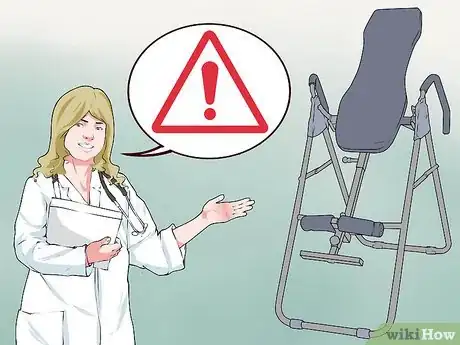

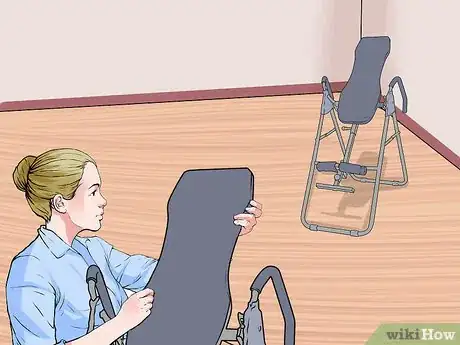
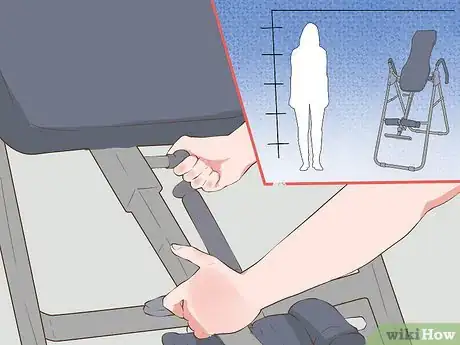
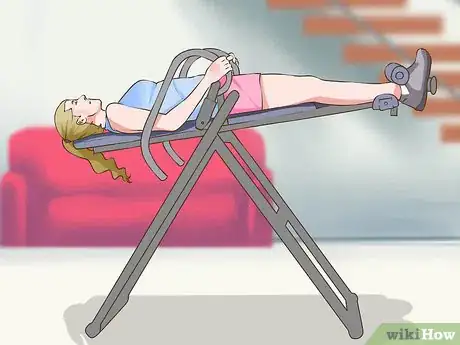
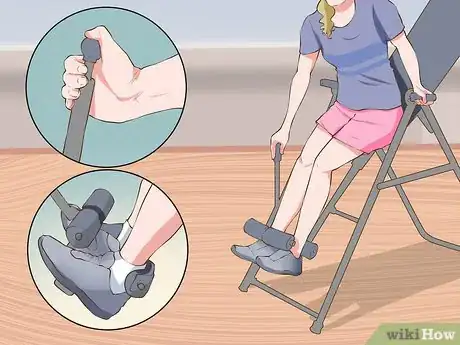
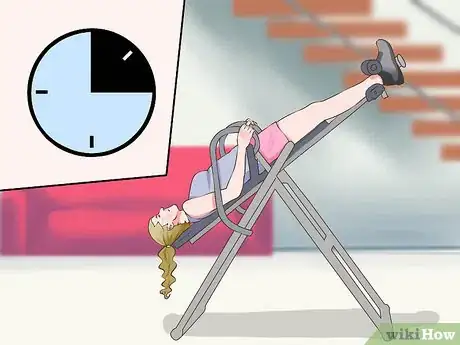
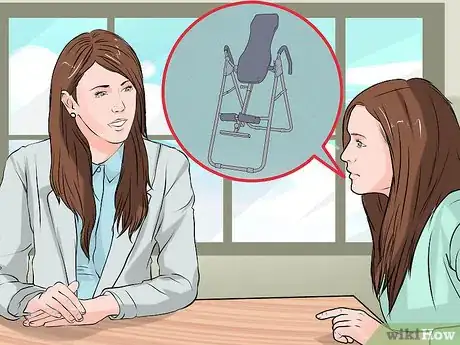
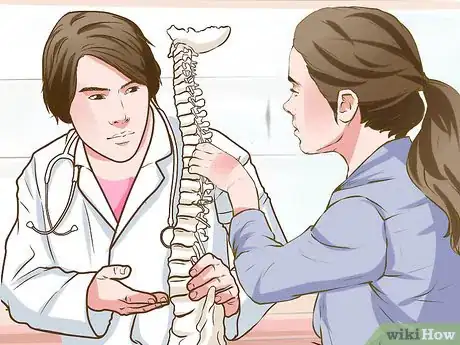
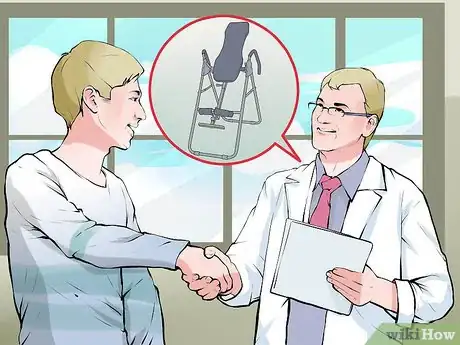



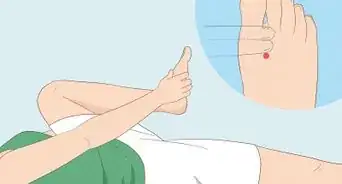




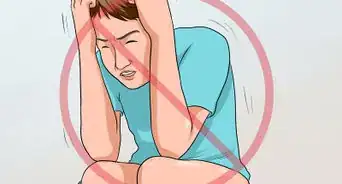














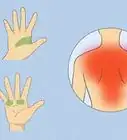






































Medical Disclaimer
The content of this article is not intended to be a substitute for professional medical advice, examination, diagnosis, or treatment. You should always contact your doctor or other qualified healthcare professional before starting, changing, or stopping any kind of health treatment.
Read More...